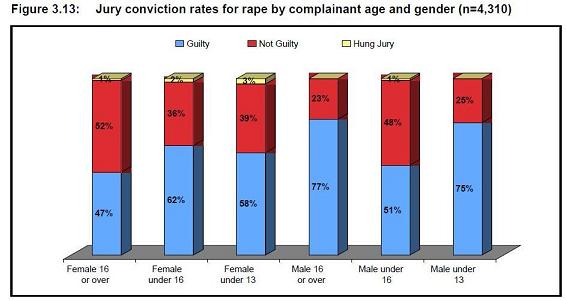Juries not to blame for rapists going free
“Contrary to popular belief and previous Government reports, juries actually convict more often than they acquit in rape cases” concludes Professor Cheryl Thomas of University College London in a report published today.
Her report ranges widely, covering all offences and finding juries not guilty of most of the criticisms made of them. It is well worth reading. But the point at which she departs most clearly from past claims and assumptions is in the area of sexual offences and rape.
Her source material is far more comprehensive that that used in earlier assessments, such as the 2005 Home Office report A gap or a chasm? Attrition in reported rape cases, by Liz Kelly, Jo Lovett and Linda Regan of the Child and Woman Abuse Studies Unit at London Metropolitan University.
Dr Kelly and colleagues found conviction rates in rapes and attempted rapes of adult females and males brought to court between 1998 and 2002 to range between 21 and 28 per cent (Table 3.2, page 26). Where a full trial took place, they found an acquittal was the more likely outcome than a conviction (57 per cent acquittals, 43 per cent convictions).
They looked in greater detail at 183 cases that resulted in a guilty verdict and compared them with other reported cases, concluding that cases involving under-16s were more likely to result in a conviction (15 per cent) than those involving those between 26 to 35 (6 per cent).
Other studies have claimed that jurors’ prejudicial attitudes to women are what accounts for the low conviction rates.
Professor Thomas finds none of these claims proven. She based her findings on 4,310 jury verdicts in rape cases in 2006-08 across all courts in England and Wales. She found that rape does not, in fact, have one of the lowest conviction rates: juries convict more often than they acquit (55 per cent conviction rate).
This is higher than for unlawful wounding, attempted murder, manslaughter, GBH, common assault and threatening to kill. The overall conviction rate for all offences that go before a jury is 63.7 per cent.
Nor is there evidence of any prejudice against women. Most rape complaints originate from women, and the conviction rate is 54 per cent. But the figure shows considerable variations by age and sex.

Professor Thomas’s conclusion is that a jury’s propensity to convict or acquit in rape cases is not necessarily due to juror attitudes to female complainants.
Of course, her report does not address what happens before a case reaches court, where most of the “attrition” takes place. “There is no doubt that the proportion of rape allegations reported to police than end in conviction is extremely low but it is also clear that this is not due to any widespread jury failure to convict in rape cases” she concludes.




christopher crossman (not verified) wrote,
Fri, 19/02/2010 - 16:13
hm, interesting. I don't know how impartial a body called the "child and woman abuse unit" can be ... I would have thought the Mandy Rice Davis principle would apply (they would say that woudn't they?)
Robert Whiston (not verified) wrote,
Fri, 26/02/2010 - 13:39
Crossman's opinions really do advance the sum of human knowledge ! ! The article's sauthor has even gone as far as to provide a link to "Are juries fair ?" Were he to use it and read only the sex offence section he would have a lot more to say and it would probably all have gravitas.
Robert Whiston (not verified) wrote,
Mon, 01/03/2010 - 16:52
It cannot be 'just a coincidence' that the report, "Are Juries Fair ?", was sponsored by the Min of Justice and not the Home Office.
For those of us who have advised the HO from time to time on such matters this truthful revelation has been ten years in the making.
We now have at least an "officialised" ministry paper laying out what has really been going on with regard to rape reports, juries and convictions.
A paper such as this would not have been contemplated 10 years ago when the HO policy team decided that they were going to pull the net so tight that no man would in future 'slip through' and every man charged (they fully expected) would be convicted.
What they could not contenance then, as it smashed their paradigm, was the phenomenon of the "falsely accused" and the innocent wrongly convicted to jail.
Each 'reported' rape has many more victims - not just one. This still haunts them.
Officialdom has still to recognise the category of the falsely accused and ther wronged imprisoned. Arguably, if there are, say, 12,000 Reported Rapes pa, and 2,000 rape convictions, then somewhere in the country there are 10,000 men that have had their world turned upside down.
But then the HO team I knew, didn't seem to care about such travesties of justice.
In an adult world we cannot act like children - omitting the thousansds of falsely accused in every report won't make them go away.
Of "Justice delayed is justice denied" then surely "Justice denied is no justice at all." ?
MelindaY (not verified) wrote,
Mon, 06/09/2010 - 07:45
Seems like the rate goes higher for girls below 17. Gov should put serious action in informing citizens about the past child molesters. Also, I agree of localization is legalized in more states. It might open other alternatives to these rapists..London Escorts